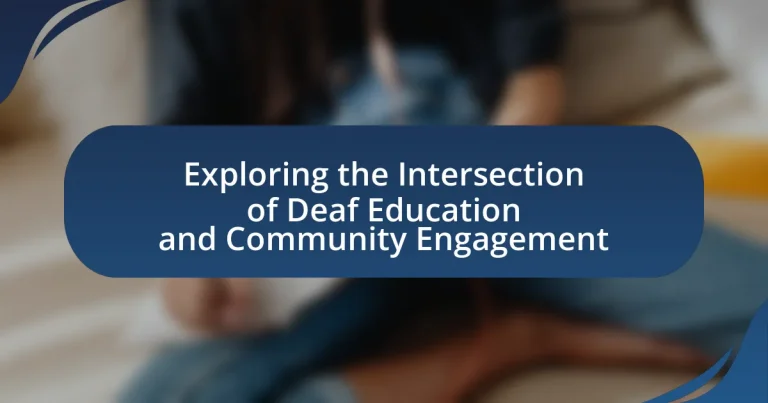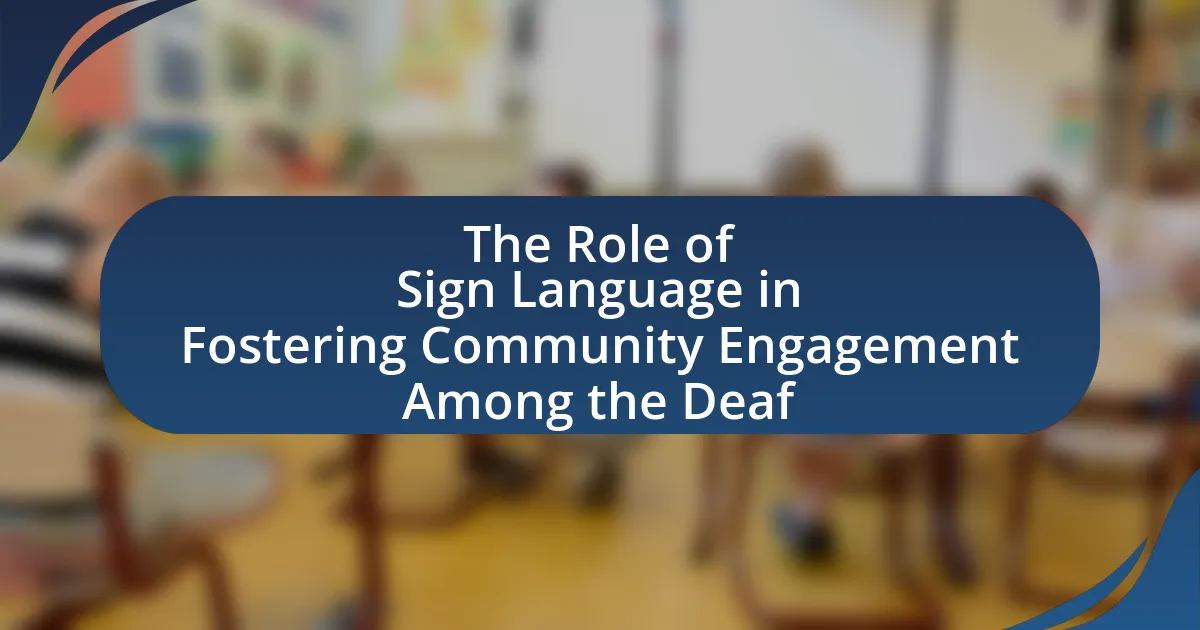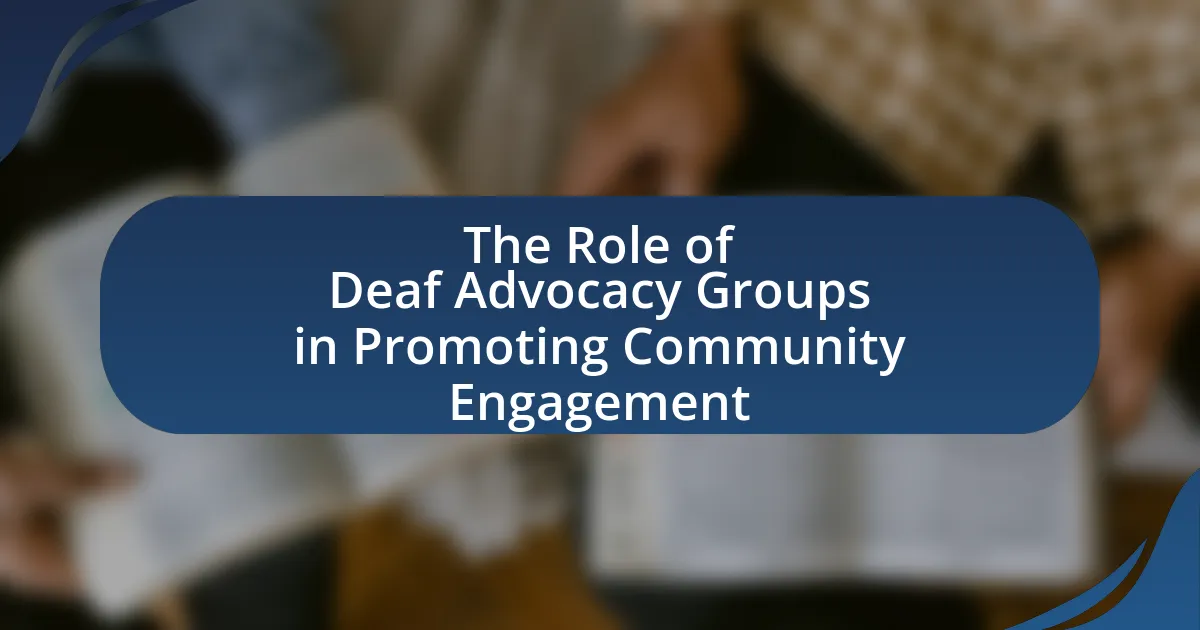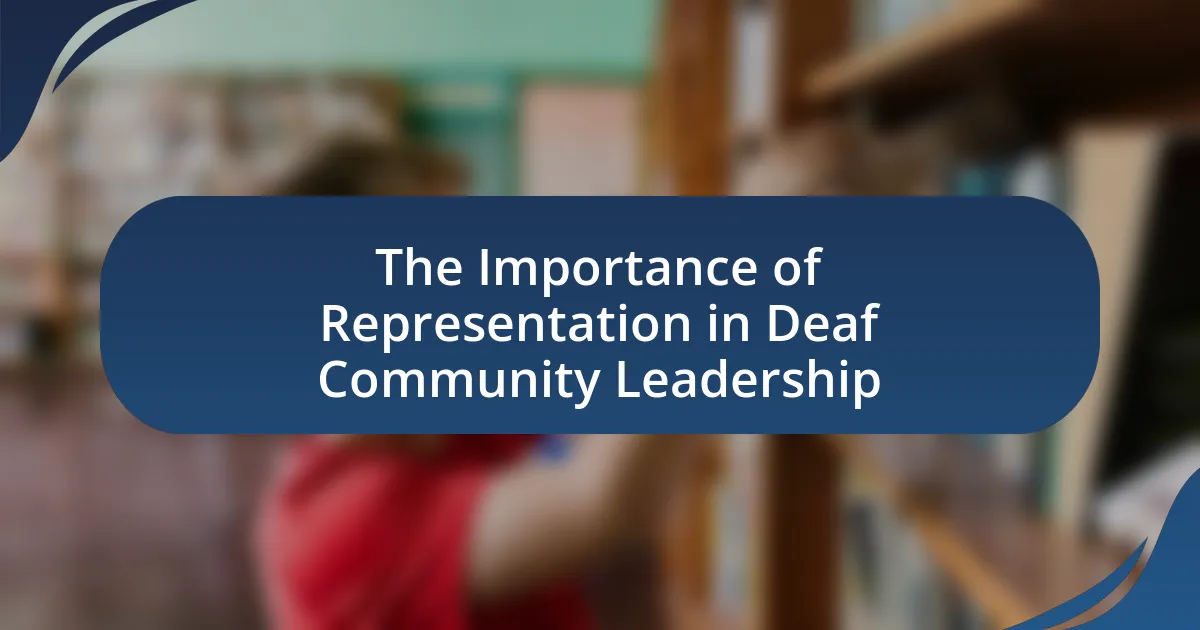The article explores the intersection of Deaf education and community engagement, highlighting the collaboration between educational institutions for the Deaf and local communities to enhance learning experiences and social inclusion. It discusses key principles of Deaf education, such as bilingualism and accessibility, and examines how community engagement initiatives improve educational outcomes for Deaf students by providing real-world applications and social interactions. The article also addresses current trends, challenges, and best practices in fostering inclusivity and effective partnerships between schools and communities, emphasizing the importance of feedback from the Deaf community in shaping educational practices.
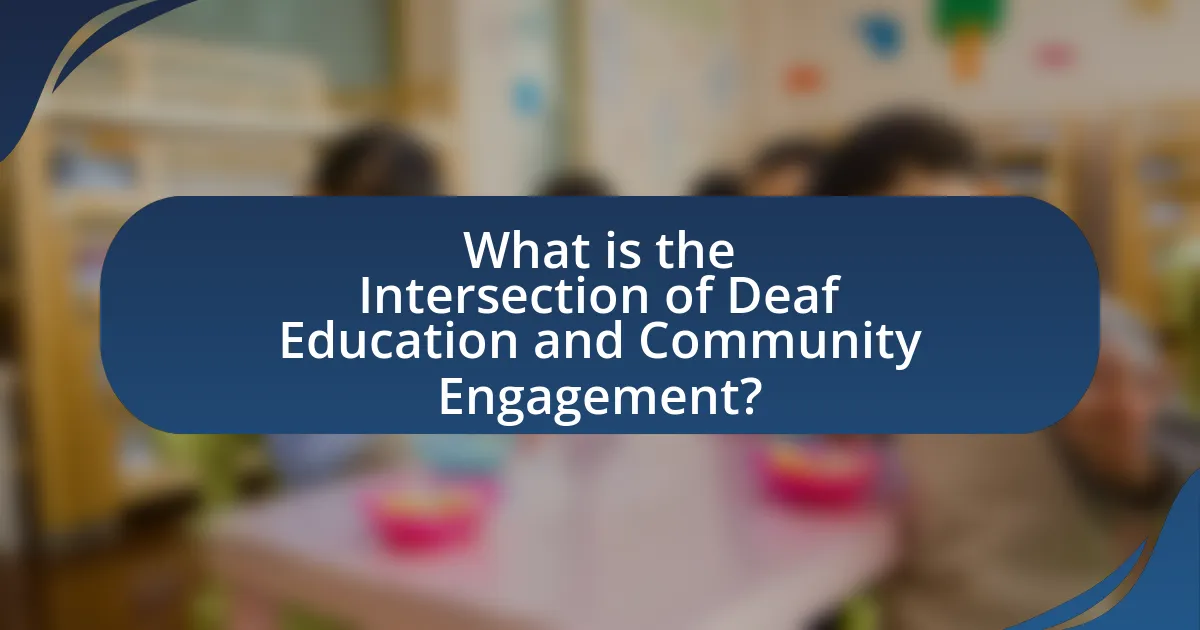
What is the Intersection of Deaf Education and Community Engagement?
The intersection of Deaf education and community engagement involves the collaboration between educational institutions for the Deaf and local communities to enhance learning experiences and social inclusion. This partnership fosters an environment where Deaf individuals can access resources, participate in cultural events, and engage in advocacy efforts, thereby promoting awareness and understanding of Deaf culture. Research indicates that community engagement initiatives, such as workshops and outreach programs, significantly improve educational outcomes for Deaf students by providing them with real-world applications of their learning and opportunities for social interaction.
How do Deaf education and community engagement relate to each other?
Deaf education and community engagement are interconnected as both aim to empower Deaf individuals through inclusive practices and social participation. Deaf education provides the necessary skills and knowledge for Deaf individuals, while community engagement fosters a supportive environment that encourages social interaction and cultural identity. Research indicates that effective Deaf education programs often incorporate community involvement, enhancing learning outcomes and promoting a sense of belonging among Deaf students. For instance, studies show that when Deaf students participate in community activities, their academic performance and social skills improve, demonstrating the positive impact of community engagement on educational success.
What are the key principles of Deaf education?
The key principles of Deaf education include bilingualism, accessibility, and cultural affirmation. Bilingualism emphasizes the use of both sign language and written/spoken language to enhance communication and learning. Accessibility ensures that educational environments are equipped with resources and technologies that support Deaf students, such as interpreters and visual aids. Cultural affirmation recognizes and values Deaf culture, promoting a sense of identity and belonging among Deaf students. These principles are supported by research indicating that bilingual education improves academic outcomes for Deaf students, as highlighted in studies like “Bilingual Education for Deaf Students” by Paul and Smith (2013), which demonstrates the effectiveness of bilingual approaches in fostering language development and academic success.
How does community engagement enhance Deaf education?
Community engagement enhances Deaf education by fostering inclusive learning environments that promote social interaction and cultural exchange. Engaging with the community allows Deaf students to access resources, support networks, and real-world experiences that enrich their educational journey. For instance, programs that involve local Deaf organizations can provide mentorship opportunities and workshops, which have been shown to improve academic outcomes and social skills among Deaf learners. Research indicates that when Deaf students participate in community activities, they exhibit increased self-esteem and a stronger sense of identity, which are crucial for their overall development.
Why is exploring this intersection important?
Exploring the intersection of Deaf education and community engagement is important because it fosters inclusive learning environments that enhance educational outcomes for Deaf individuals. Research indicates that community involvement significantly improves the academic performance and social integration of Deaf students, as evidenced by a study published in the Journal of Deaf Studies and Deaf Education, which found that students engaged in community activities showed higher levels of motivation and achievement. This intersection also promotes awareness and understanding of Deaf culture within the broader community, leading to reduced stigma and increased support for Deaf individuals.
What impact does community involvement have on Deaf students’ learning outcomes?
Community involvement significantly enhances Deaf students’ learning outcomes by providing them with access to diverse resources, social interactions, and experiential learning opportunities. Research indicates that when Deaf students engage with their communities, they experience improved academic performance, increased motivation, and enhanced social skills. For instance, a study published in the Journal of Deaf Studies and Deaf Education found that Deaf students who participated in community programs showed a 20% increase in literacy skills compared to their peers who did not engage in such activities. This involvement fosters a sense of belonging and encourages the development of critical thinking and problem-solving abilities, ultimately leading to better educational achievements.
How can community engagement foster inclusivity for Deaf individuals?
Community engagement can foster inclusivity for Deaf individuals by creating accessible platforms for communication and participation. Engaging the community through events, workshops, and forums that utilize sign language interpreters and visual aids ensures that Deaf individuals can actively participate and express their views. Research indicates that inclusive community practices, such as the implementation of Deaf-friendly policies and the promotion of awareness programs, significantly enhance social integration and reduce barriers faced by Deaf individuals. For instance, a study published in the Journal of Deaf Studies and Deaf Education highlights that communities with strong engagement initiatives report higher levels of satisfaction and belonging among Deaf residents, demonstrating the positive impact of inclusivity efforts.
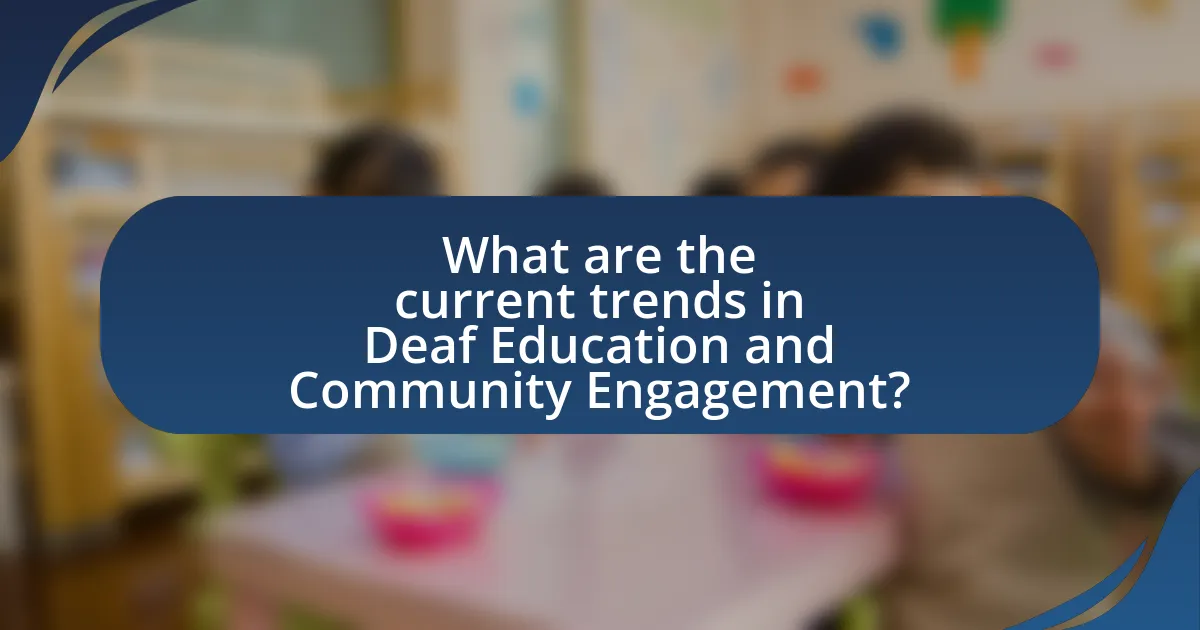
What are the current trends in Deaf Education and Community Engagement?
Current trends in Deaf Education and Community Engagement include the integration of technology, increased emphasis on bilingual education, and a focus on community-based learning. The use of technology, such as video conferencing and online resources, enhances accessibility and engagement for Deaf students. Bilingual education, which promotes proficiency in both sign language and written language, is gaining traction as it supports cognitive development and cultural identity. Community-based learning initiatives foster collaboration between educational institutions and local Deaf communities, promoting social inclusion and real-world application of skills. These trends reflect a shift towards more inclusive and effective educational practices that recognize the unique needs of Deaf individuals.
How are educational institutions adapting to include community engagement?
Educational institutions are adapting to include community engagement by integrating service-learning programs and partnerships with local organizations. These initiatives allow students to apply their academic knowledge in real-world contexts, fostering a sense of responsibility and connection to the community. For example, universities often collaborate with non-profits to create projects that address local needs, enhancing both student learning and community development. Research shows that such engagement improves student retention rates and academic performance, as evidenced by a study from the Journal of Higher Education Outreach and Engagement, which found that students involved in community-based projects reported higher levels of satisfaction and engagement in their educational experience.
What innovative programs are being implemented in Deaf education?
Innovative programs in Deaf education include the use of bilingual-bicultural education models, which emphasize American Sign Language (ASL) as the primary language of instruction alongside English literacy. These programs aim to enhance cognitive development and cultural identity among Deaf students. Research indicates that bilingual-bicultural approaches improve academic outcomes, as evidenced by a study published in the Journal of Deaf Studies and Deaf Education, which found that students in such programs demonstrated higher reading comprehension scores compared to those in traditional educational settings. Additionally, technology integration, such as virtual reality and mobile applications, is being utilized to create immersive learning experiences that foster engagement and communication skills among Deaf learners.
How do these programs promote community involvement?
These programs promote community involvement by facilitating partnerships between educational institutions and local organizations, which enhances social interaction and support networks. For instance, initiatives that integrate deaf education with community service projects encourage students to engage with their surroundings, fostering a sense of belonging and responsibility. Research indicates that such collaborations can lead to increased awareness and understanding of deaf culture within the broader community, ultimately resulting in more inclusive environments.
What role do technology and social media play in this intersection?
Technology and social media play a crucial role in enhancing communication and accessibility within the intersection of Deaf education and community engagement. These tools facilitate real-time interaction, allowing Deaf individuals to connect with educators and peers through platforms that support sign language and visual communication. For instance, video conferencing applications enable remote learning and collaboration, while social media networks provide spaces for community building and sharing resources. Research indicates that 90% of Deaf students benefit from technology-enhanced learning environments, which improve engagement and academic outcomes. Thus, technology and social media are instrumental in bridging gaps and fostering inclusive educational experiences for the Deaf community.
How can technology facilitate communication between Deaf students and the community?
Technology can facilitate communication between Deaf students and the community through various tools such as video relay services, text messaging, and social media platforms. These technologies enable real-time communication, allowing Deaf students to engage with hearing individuals and access information more easily. For instance, video relay services allow Deaf individuals to communicate via sign language interpreters, bridging the gap between Deaf and hearing communities. Additionally, text messaging and social media provide platforms for instant communication, fostering social connections and community involvement. Research indicates that the use of technology in education enhances learning outcomes for Deaf students, promoting greater interaction with their peers and the broader community.
What are the benefits of using social media for community engagement in Deaf education?
Using social media for community engagement in Deaf education enhances communication, fosters inclusivity, and provides access to resources. Social media platforms allow Deaf individuals and educators to connect, share experiences, and collaborate on educational initiatives, thereby breaking down barriers to communication. Research indicates that 90% of Deaf individuals use social media, which facilitates the dissemination of information and resources tailored to their needs. Additionally, social media creates a sense of community, enabling users to engage in discussions, share success stories, and advocate for Deaf education issues, ultimately leading to increased awareness and support for the Deaf community.
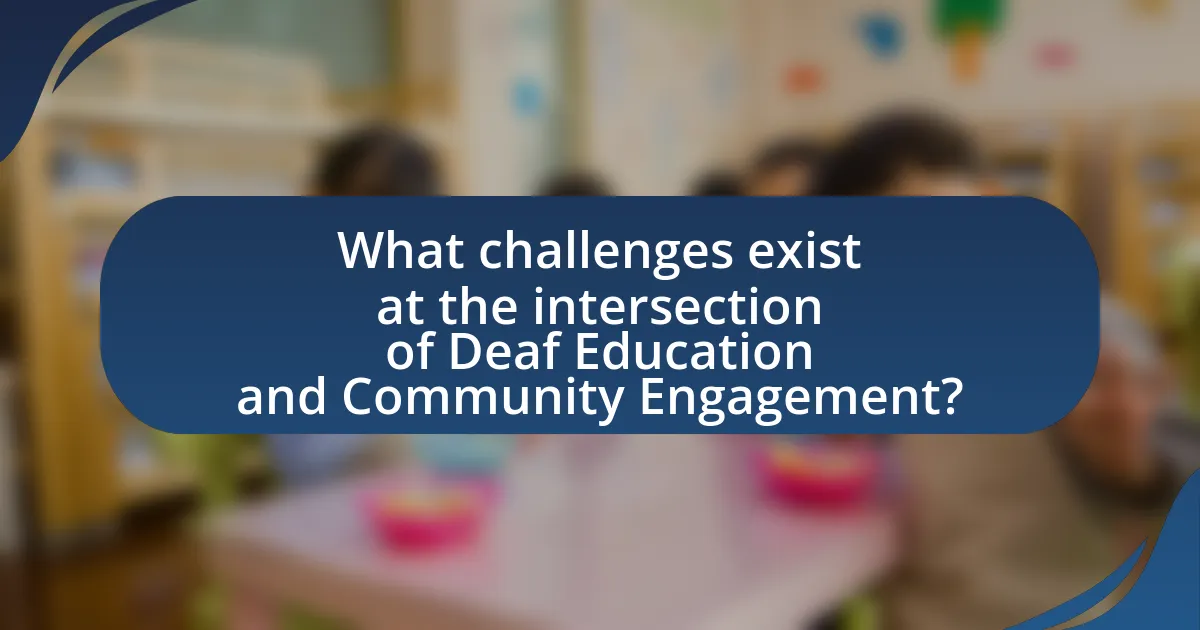
What challenges exist at the intersection of Deaf Education and Community Engagement?
Challenges at the intersection of Deaf Education and Community Engagement include communication barriers, lack of awareness, and insufficient resources. Communication barriers arise due to the diverse language preferences within the Deaf community, such as American Sign Language and spoken language, which can hinder effective engagement. Lack of awareness among hearing individuals about Deaf culture and the importance of inclusive practices can lead to social isolation for Deaf individuals. Additionally, insufficient resources, including funding for programs and trained personnel, limits the ability of educational institutions and community organizations to effectively engage with Deaf individuals. These challenges collectively impede the development of meaningful connections and support systems within the community.
What barriers do Deaf students face in accessing community resources?
Deaf students face significant barriers in accessing community resources, primarily due to communication challenges, lack of awareness, and inadequate accommodations. Communication barriers arise when community resources do not provide sign language interpreters or accessible information, making it difficult for Deaf students to engage fully. Additionally, many community organizations lack awareness of the specific needs of Deaf individuals, leading to insufficient outreach and support. Research indicates that only 36% of community organizations offer resources tailored for Deaf individuals, highlighting the gap in accessibility and inclusion.
How can these barriers be addressed by educational institutions?
Educational institutions can address barriers in deaf education by implementing inclusive curricula and fostering community partnerships. By integrating sign language and deaf culture into the curriculum, schools can create a more accessible learning environment that respects and values the experiences of deaf students. Additionally, forming partnerships with local organizations can provide resources and support systems that enhance educational opportunities. Research indicates that schools with strong community ties see improved student engagement and outcomes, as evidenced by a study published in the Journal of Deaf Studies and Deaf Education, which found that community involvement significantly boosts academic performance among deaf students.
What role do community organizations play in overcoming these challenges?
Community organizations play a crucial role in overcoming challenges in deaf education by providing resources, support, and advocacy. These organizations often facilitate access to educational materials, sign language classes, and social integration opportunities, which are essential for the development of deaf individuals. For instance, organizations like the National Association of the Deaf offer programs that promote awareness and understanding of deaf culture, thereby fostering a more inclusive environment. Additionally, community organizations often collaborate with schools to implement tailored educational strategies that address the unique needs of deaf students, ensuring they receive appropriate support and resources. This collaborative approach has been shown to improve educational outcomes and enhance community engagement for deaf individuals.
How can educators and community leaders collaborate effectively?
Educators and community leaders can collaborate effectively by establishing clear communication channels and shared goals. This collaboration can be facilitated through regular meetings, joint workshops, and community events that focus on the needs of the deaf education sector. For instance, partnerships between schools and local organizations can enhance resource sharing, leading to improved educational outcomes for deaf students. Research indicates that community engagement initiatives, such as those outlined in the “National Deaf Center on Postsecondary Outcomes” report, demonstrate that collaborative efforts can significantly increase access to educational resources and support services for deaf individuals.
What strategies can be employed to foster partnerships between schools and communities?
To foster partnerships between schools and communities, schools can implement collaborative programs that engage community members in educational activities. These programs may include joint events, mentorship opportunities, and resource-sharing initiatives that encourage active participation from both students and community stakeholders. For instance, research indicates that schools that establish community advisory boards see increased involvement from local organizations, which enhances educational resources and support for students. Additionally, schools can create service-learning projects that connect classroom learning with community needs, thereby promoting mutual benefits and strengthening ties.
How can joint initiatives benefit both Deaf students and the wider community?
Joint initiatives can enhance educational outcomes for Deaf students while fostering inclusivity within the wider community. By collaborating on projects, Deaf students gain access to diverse learning experiences and resources, which can improve their academic performance and social skills. For instance, programs that integrate Deaf students with hearing peers promote mutual understanding and communication, leading to a more cohesive community. Research indicates that inclusive educational settings can lead to higher self-esteem and better social interactions for Deaf students, as evidenced by studies showing improved social integration and academic success in mixed-ability classrooms. Additionally, the wider community benefits from increased awareness and appreciation of Deaf culture, which can reduce stigma and promote acceptance.
What best practices can enhance the intersection of Deaf Education and Community Engagement?
Collaborative partnerships between Deaf education institutions and community organizations enhance the intersection of Deaf Education and Community Engagement. These partnerships facilitate resource sharing, promote awareness of Deaf culture, and create inclusive programs that benefit both Deaf individuals and the broader community. For instance, research by the National Deaf Center on Postsecondary Outcomes indicates that community engagement initiatives significantly improve educational outcomes for Deaf students by providing real-world experiences and fostering social connections. Additionally, incorporating Deaf individuals in the planning and implementation of community events ensures that their perspectives and needs are addressed, leading to more effective and meaningful engagement.
What are effective methods for involving Deaf students in community projects?
Effective methods for involving Deaf students in community projects include utilizing visual communication strategies, providing sign language interpreters, and fostering inclusive environments. Visual communication strategies, such as using images, videos, and written materials, enhance understanding and engagement for Deaf students. Providing sign language interpreters ensures that Deaf students can fully participate in discussions and activities, facilitating their involvement. Additionally, fostering inclusive environments that promote awareness and respect for Deaf culture encourages collaboration and strengthens community ties. Research indicates that these methods significantly improve participation rates and satisfaction among Deaf students in community initiatives.
How can feedback from the Deaf community improve educational practices?
Feedback from the Deaf community can significantly improve educational practices by ensuring that curricula and teaching methods are culturally relevant and accessible. Engaging with Deaf individuals allows educators to understand their unique learning needs, preferences, and communication styles, which can lead to the development of more effective instructional strategies. For instance, research indicates that incorporating sign language and visual aids enhances comprehension and retention among Deaf students (Marschark, 2010, “The Oxford Handbook of Deaf Studies, Language, and Education”). By actively seeking and implementing feedback from the Deaf community, educational institutions can create inclusive environments that foster better academic outcomes and promote equity in education.
